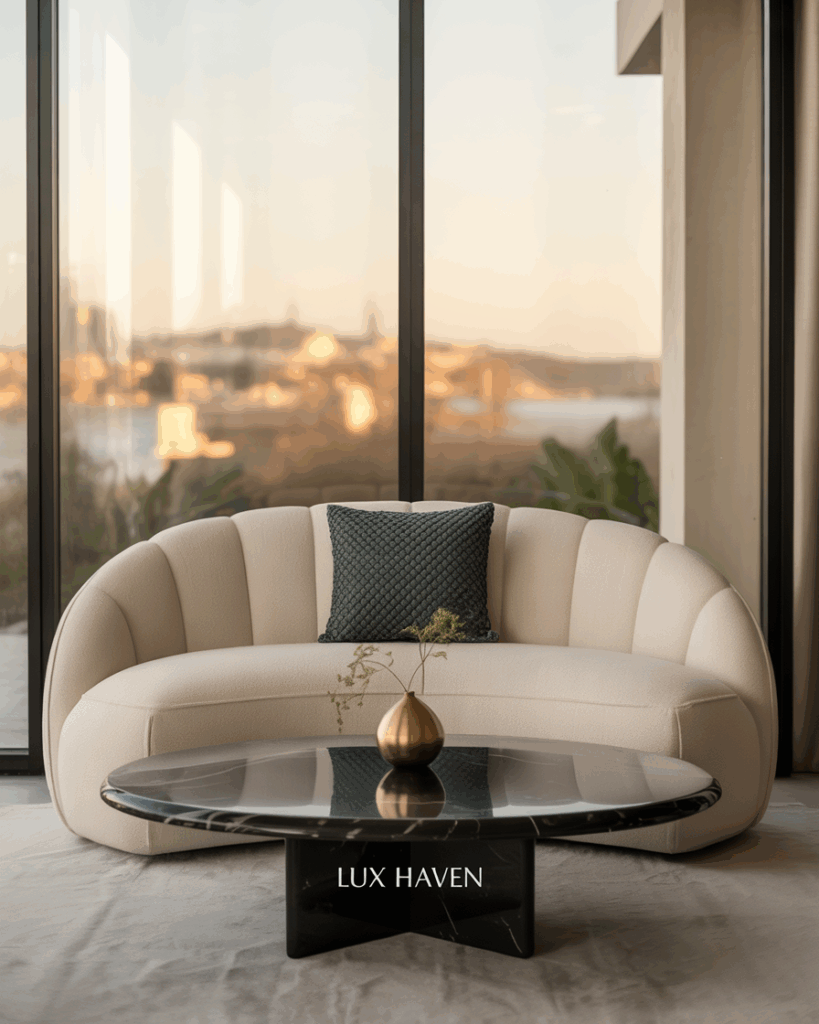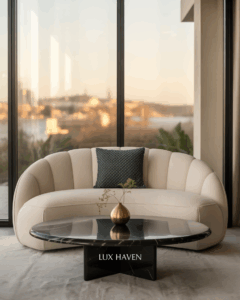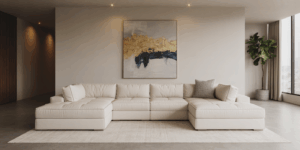Living in a small property doesn’t mean compromising on style or comfort. In fact, some of the most beautiful and functional homes are those where every square metre has been thoughtfully considered and maximised. Whether you’re dealing with a studio flat in London, a compact terraced house, or a cosy cottage, the key lies in understanding how to work with your space rather than against it.
As someone who’s spent years helping clients transform cramped quarters into airy, functional homes, I’ve discovered that the secret isn’t about making rooms bigger—it’s about making them feel bigger whilst ensuring they work harder for you. Here are my top five strategies for maximising space in small properties, each one tried and tested in real homes across the UK.
1. Master the Art of Vertical Storage
When floor space is at a premium, the only way is up. Vertical storage is perhaps the most underutilised resource in small homes, yet it offers tremendous potential for decluttering and organising your belongings without encroaching on precious living space.
Start by looking at your walls with fresh eyes. That blank wall in your hallway could house floor-to-ceiling built-in shelving. The space above your sofa might be perfect for floating shelves that display books and decorative objects. Even the area above doorways can accommodate narrow shelving for items you don’t need daily access to.
In the kitchen, consider extending your cupboards right up to the ceiling. Yes, you’ll need a step ladder to reach the top shelves, but they’re ideal for storing seasonal items, large serving dishes, or appliances you only use occasionally. The visual impact of unbroken lines from floor to ceiling also creates the illusion of height, making your room feel more spacious.
Bedrooms benefit enormously from vertical thinking too. Instead of a traditional bedside table, consider a tall, narrow unit that provides storage without eating into floor space. Wardrobes that extend to the ceiling offer significantly more storage than standard height ones, and the unbroken line creates a sleek, modern look.
Don’t overlook awkward spaces either. The area under your stairs could house a custom-built storage unit, complete with hanging space for coats and compartments for shoes, bags, and household items. These dead spaces are goldmines for storage when approached creatively.
2. Embrace Multi-Functional Furniture
In small properties, every piece of furniture should earn its place by serving multiple purposes. This doesn’t mean filling your home with gimmicky gadgets, but rather investing in well-designed pieces that combine form with clever functionality.
Storage ottomans are perfect examples of multi-functional furniture done right. They provide comfortable seating, a surface for drinks or books, and concealed storage for throws, magazines, or children’s toys. Choose one in a fabric that complements your colour scheme, and it becomes a stylish accent piece too.
Dining tables that extend when needed but remain compact for daily use are essential in small homes. Look for designs with built-in storage compartments or drawers where you can keep placemats, napkins, and cutlery. Some modern designs even incorporate charging stations for phones and tablets.
In bedrooms, consider a bed with built-in storage drawers or a lift-up mattress that reveals a spacious compartment underneath. These solutions are far more elegant than having storage boxes cluttering your bedroom floor, and they keep bedding, out-of-season clothes, or spare pillows easily accessible but out of sight.
Coffee tables with lower shelves or hidden compartments keep living rooms tidy whilst providing surfaces for entertainment. Some designs feature tops that lift to reveal storage space perfect for remote controls, magazines, or board games.
“The most successful small spaces are those where furniture works overtime. Every piece should have at least two functions, and ideally three. It’s not about cramming more in—it’s about making each item work harder and smarter.” – Rachel Buscall
3. Create Zones to Define Different Areas
Open-plan living is often a necessity in small properties, but without careful planning, it can result in chaotic, undefined spaces that feel cramped rather than airy. The solution lies in creating distinct zones that serve different purposes whilst maintaining the sense of openness.
Room dividers don’t have to be walls. A strategically placed bookshelf can separate your living area from your workspace whilst providing storage and display space on both sides. Choose an open-backed design to maintain light flow and visual continuity between areas.
Rugs are powerful tools for defining zones. A large rug under your seating area creates a distinct living zone, whilst a smaller rug under your dining table establishes that area’s boundaries. Choose rugs that complement each other to maintain cohesion throughout the space.
Lighting plays a crucial role in zone definition too. Pendant lights over a dining table, a floor lamp in the reading corner, and table lamps in the living area create distinct pools of light that naturally separate different functions without physical barriers.
Consider using different ceiling heights where possible. If you’re renovating, creating a slightly lower ceiling over the kitchen area (perhaps to conceal services) whilst maintaining full height in the living space can effectively separate the two zones whilst adding architectural interest.
Colour can also define zones subtly. Using a deeper shade on one wall or incorporating different accent colours in different areas helps establish separate identities for each zone whilst maintaining overall harmony.
4. Harness the Power of Light and Mirrors
Light is your greatest ally in making small spaces feel larger. Natural light should be maximised wherever possible, but artificial lighting strategy is equally important for creating the illusion of space and ensuring your home feels welcoming rather than cramped.
Start with your windows. Heavy curtains that block natural light are the enemy of small spaces. Instead, opt for sheer fabrics, Roman blinds, or shutters that can be fully opened during the day. If privacy is a concern, consider frosted window film on the lower portion of windows, allowing light to flood in whilst maintaining discretion.
Mirrors are magical in small spaces, but they need to be positioned thoughtfully. A large mirror opposite a window will reflect natural light throughout the room and create the illusion of another window, effectively doubling your natural light source. Mirrored wardrobes in bedrooms serve dual purposes, providing essential storage whilst making the room feel twice its actual size.
Consider mirrored splashbacks in kitchens instead of traditional tiles. They reflect light around the space and create visual depth, making compact kitchens feel more open and airy. The key is to ensure they’re easy to clean and positioned where they won’t show every fingerprint.
Artificial lighting should be layered to avoid harsh shadows that make spaces feel smaller. Combine overhead lighting with table lamps, floor lamps, and accent lighting. LED strip lights under kitchen cupboards or behind floating shelves add depth and create the impression of floating surfaces.
Glass furniture also contributes to the sense of space. Glass dining tables, acrylic chairs, or transparent coffee tables maintain visual flow and don’t create visual barriers that can make rooms feel cluttered.
5. Implement Smart Storage Solutions
Effective storage in small properties requires thinking beyond traditional cupboards and wardrobes. Every nook, cranny, and unused space presents an opportunity for clever storage solutions that keep your belongings organised whilst maintaining a clutter-free environment.
The space under your bed is prime real estate for storage, but rather than using it as a dumping ground for random items, invest in proper under-bed storage solutions. Vacuum-packed storage bags are perfect for seasonal bedding and clothes, whilst shallow drawers on wheels can house shoes, accessories, or spare toiletries.
In bathrooms, make use of the space above the toilet with a narrow cabinet or floating shelves. The back of the bathroom door can accommodate over-door organisers for towels, cleaning supplies, or toiletries. Even the space inside vanity unit doors can be maximised with hanging organisers for hair tools and smaller items.
Kitchen storage requires particular creativity in small properties. Magnetic strips on walls hold knives and metal utensils, freeing up drawer space. The inside of cupboard doors can accommodate spice racks, cutting board storage, or cleaning supply organisers. Pull-out drawers in base units make accessing items at the back much easier and more efficient than traditional shelves.
Consider the often-wasted space at the top of rooms. High-level storage accessed by a library ladder might seem dramatic, but it’s practical for items you don’t need regular access to. This approach works particularly well in rooms with high ceilings, where the dramatic vertical lines actually enhance the sense of space.
Built-in storage, whilst requiring initial investment, often provides the most efficient use of space. Custom solutions can be designed to fit awkward corners, utilise spaces under eaves, or make the most of unusual room shapes that standard furniture can’t accommodate.
Making Small Spaces Work for Modern Living
The key to successful small space living lies in understanding that limitations often spark the most creative solutions. By thinking vertically, choosing multi-functional furniture, defining zones clearly, maximising light, and implementing smart storage, you can create a home that feels spacious, organised, and entirely your own.
Remember that maximising space isn’t about fitting more into your home—it’s about making your home work more efficiently for your lifestyle. Every decision, from the paint colour on your walls to the style of door handles you choose, contributes to the overall sense of space and functionality.
Small properties offer unique opportunities for creativity and personalisation that larger spaces often don’t. Embrace the challenge, and you’ll discover that some of the most characterful, comfortable, and efficient homes are those where every detail has been carefully considered and every square metre thoughtfully planned.





